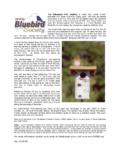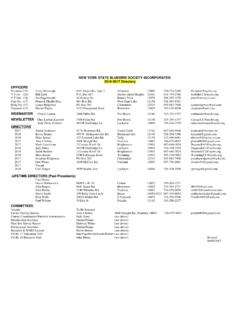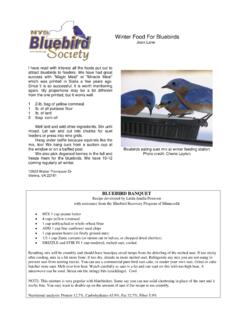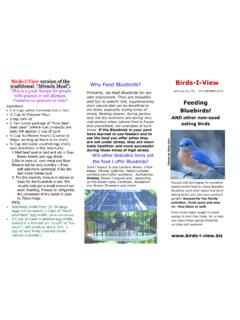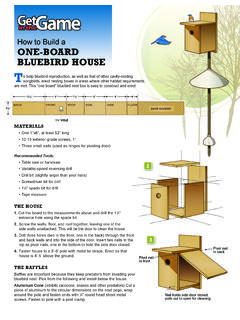Transcription of BLOWFLIES AND BLUEBIRDS - NYSBS
1 BLOWFLIES AND BLUEBIRDS Blowfly (Protocalliphora siaIia) larvae parasitism on BLUEBIRDS has been severe in recent years. We have found many bluebird and swallow nests where BLOWFLIES infestations have been heavy. There is debate within the bluebird community about the impact of these parasites on nesting success. Under ideal conditions BLOWFLIES may have little impact on nesting success, but in combination with periods of cold, prolonged rain, or low food availability they may contribute to loss of nestlings. BLOWFLY LIFE CYCLE Female BLOWFLIES lay 50-200 eggs in a bluebird 's grass nest, usually when the fledglings are first hatched.
2 More than one blowfly may lay eggs in the nest. The female dies after egg laying. The eggs hatch in 1 to 2 days into tiny tan colored larva that grow to 3/8" long. The larvae attach to the nestlings' feet, legs, underside of wings and beaks, and draw out the blood and body fluids. They primarily attack the nestlings at night and hide in the nesting material during the daylight hours. Researchers have found as many as 250 larvae in a nest. The larvae feed on the fledglings for approximately 8 days and then go into a dormant stage for 3 days where they become leathery pupa.
3 After 10-12 days the adult blowfly emerge from the puparia and fly away in search of fresh bird nests where they will repeat the 3-4 week life cycle. Therefore the incidence of blowfly infestation usually increases in the second and third nestings as the summer progresses. CONTROL Monitoring your nesting boxes for blowfly larvae may help to increase bluebird populations. Once the fledglings are hatched, check nesting boxes every 3 to 4 days. (After 13 days, monitor boxes very carefully or do not disturb the fledglings or they may fly from the nest prematurely.)
4 Open the nesting box, lift the nest slightly and carefully scrape the chaff from the bottom of the nest into your hand to detect the presence of blowfly. This will primarily indicate larvae that have completed the feeding phase of their lives. Actively feeding larvae often hide higher in the nest just below the nest cup. Although rotenone powder had been recommended to control blowfly infestations in the past, recent research indicates that it has very little effect on fly larvae. Unfortunately, rotenone is very effective in eliminating the jewel wasp (Nasonia sp.)
5 , a fruit fly-size parasite that provides natural control of the blowfly larvae. Therefore, we strongly discourage the use of rotenone in nesting boxes. If blowfly larvae are evident we recommend changing the nest. Remove the nest and fledglings then brush out the box. Build a new nest of dried lawn clippings similar to the shape of the original nest and pack it down tightly. Gently replace the nestlings. The parents will not abandon the nest due to your scent because songbirds have a very poor sense of smell. If you place the larvae you remove where they will be visible BLUEBIRDS will immediately consume them.
6 Discarding the old nest away from the nest box will lessen that chances that predators will be attracted to the site and possibly raid the nest box. A recent study indicated that it is advantageous to leave the last nest of the year in nest boxes over the winter. This allows blowfly pupa that have been parasitized by the jewel wasp to complete their life cycle and to emerge the next spring controlling blowfly populations. Nest boxes must be cleaned out in the spring before the nesting season. For further information: Please contact by email: or visit us at Rev.
7 3/07

